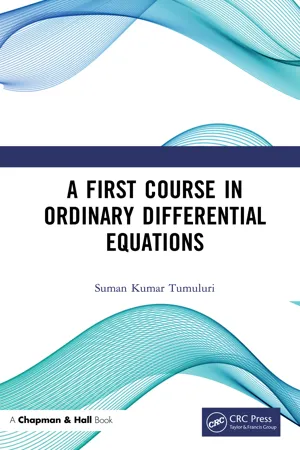
- 324 pages
- English
- ePUB (mobile friendly)
- Available on iOS & Android
A First Course in Ordinary Differential Equations
About this book
A First course in Ordinary Differential Equations provides a detailed introduction to the subject focusing on analytical methods to solve ODEs and theoretical aspects of analyzing them when it is difficult/not possible to find their solutions explicitly. This two-fold treatment of the subject is quite handy not only for undergraduate students in mathematics but also for physicists, engineers who are interested in understanding how various methods to solve ODEs work. More than 300 end-of-chapter problems with varying difficulty are provided so that the reader can self examine their understanding of the topics covered in the text.
Most of the definitions and results used from subjects like real analysis, linear algebra are stated clearly in the book. This enables the book to be accessible to physics and engineering students also. Moreover, sufficient number of worked out examples are presented to illustrate every new technique introduced in this book. Moreover, the author elucidates the importance of various hypotheses in the results by providing counter examples.
Features
-
- Offers comprehensive coverage of all essential topics required for an introductory course in ODE.
-
- Emphasizes on both computation of solutions to ODEs as well as the theoretical concepts like well-posedness, comparison results, stability etc.
-
- Systematic presentation of insights of the nature of the solutions to linear/non-linear ODEs.
-
- Special attention on the study of asymptotic behavior of solutions to autonomous ODEs (both for scalar case and 2?2 systems).
-
- Sufficient number of examples are provided wherever a notion is introduced.
-
- Contains a rich collection of problems.
This book serves as a text book for undergraduate students and a reference book for scientists and engineers. Broad coverage and clear presentation of the material indeed appeals to the readers.
Dr. Suman K. Tumuluri has been working in University of Hyderabad, India, for 11 years and at present he is an associate professor. His research interests include applications of partial differential equations in population dynamics and fluid dynamics.
Frequently asked questions
- Essential is ideal for learners and professionals who enjoy exploring a wide range of subjects. Access the Essential Library with 800,000+ trusted titles and best-sellers across business, personal growth, and the humanities. Includes unlimited reading time and Standard Read Aloud voice.
- Complete: Perfect for advanced learners and researchers needing full, unrestricted access. Unlock 1.4M+ books across hundreds of subjects, including academic and specialized titles. The Complete Plan also includes advanced features like Premium Read Aloud and Research Assistant.
Please note we cannot support devices running on iOS 13 and Android 7 or earlier. Learn more about using the app.
Information
Chapter 1
Introduction
1.1 Ordinary differential equations
1.2 Applications of ODEs
Table of contents
- Cover
- Half Title
- Title Page
- Copyright Page
- Dedication
- Contents
- Preface
- 1 Introduction
- 2 First order ODEs
- 3 Higher order linear ODEs
- 4 Boundary value problems
- 5 Systems of first order ODEs
- 6 Qualitative behavior of the solutions
- 7 Series solutions
- 8 The Laplace transforms
- 9 Numerical Methods
- Appendix A
- Appendix B
- Appendix C
- Bibliography
- Index